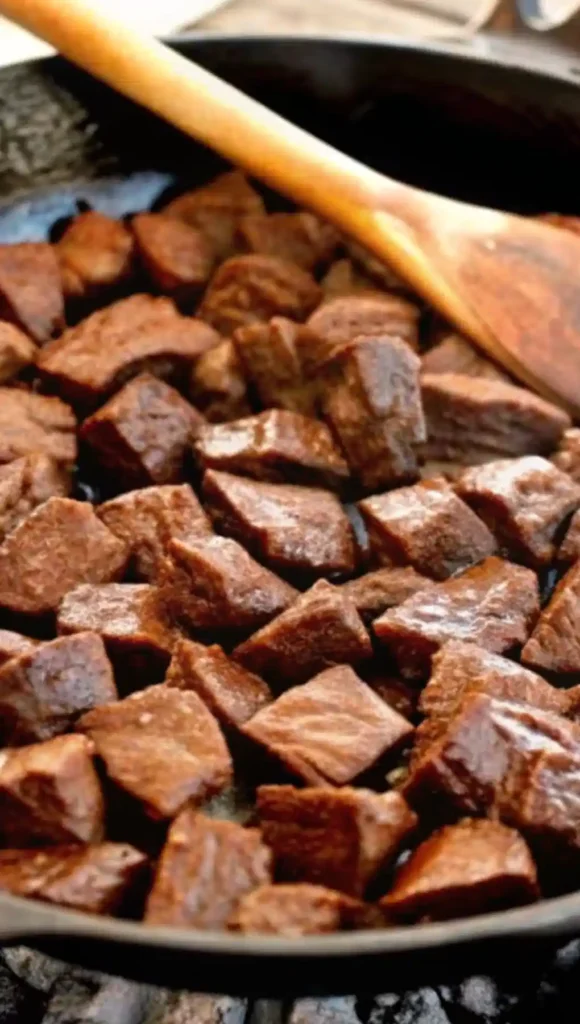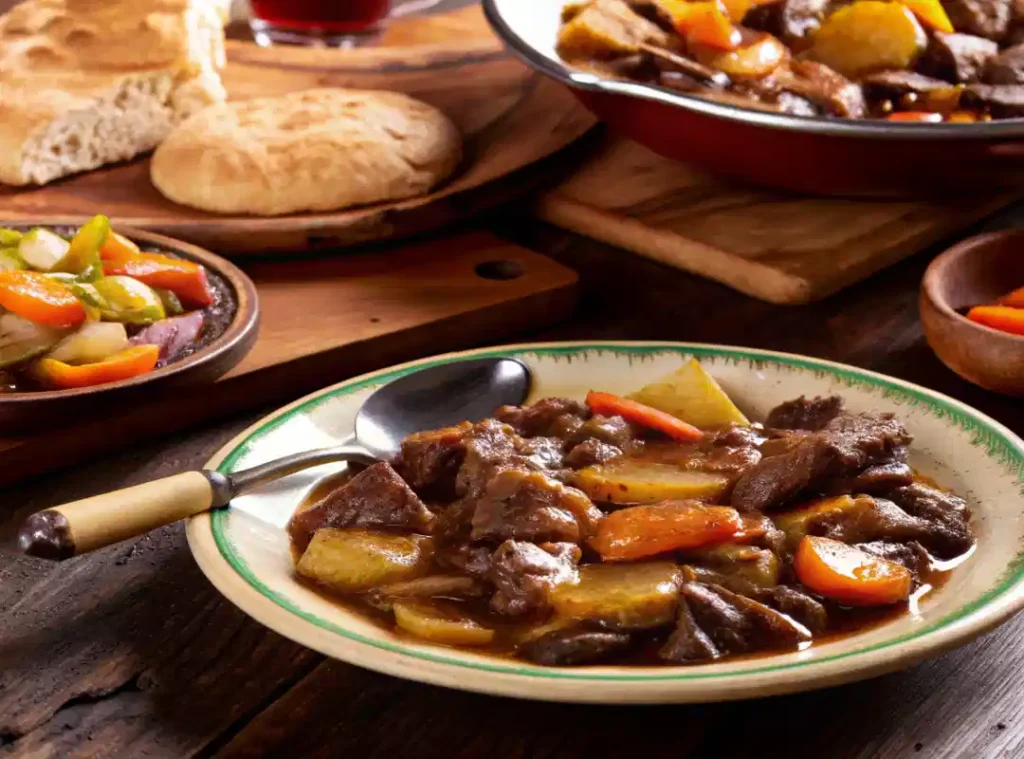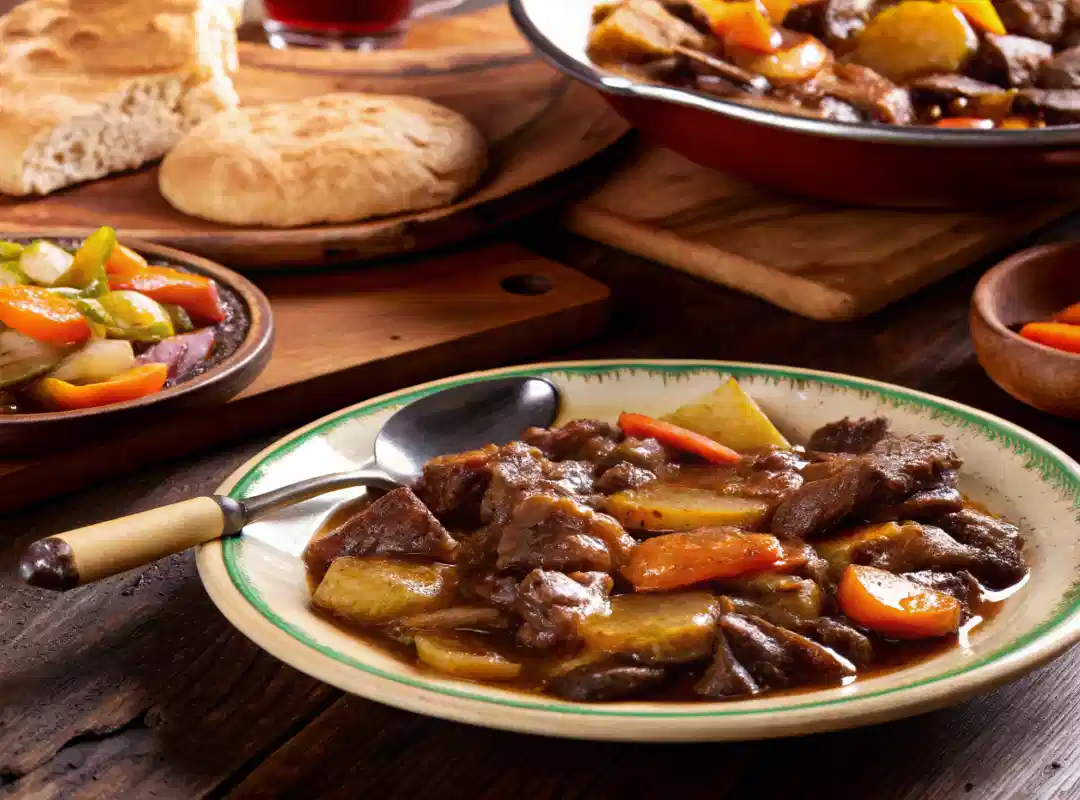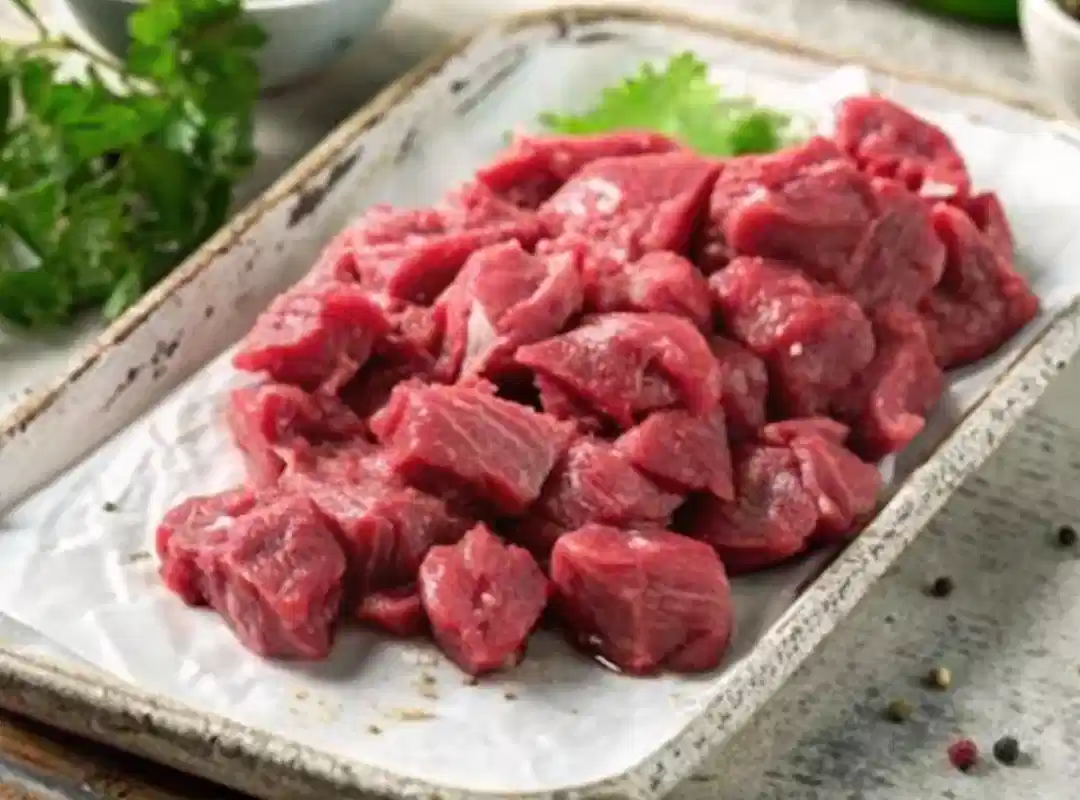Let’s be honest if you’ve ever followed an online guide on how to cook diced beef, you’ve probably ended up with one of two results: either rubbery chunks that chew like leather, or overcooked mush drowning in sauce. Sound familiar?
Most recipes skip straight to the cooking part without teaching you why beef behaves the way it does in the pan. They ignore the science behind tenderness, the subtle chemistry of browning, and the crucial match between beef cut and cooking method. And worse they assume one technique fits all, whether you’re stir-frying sirloin or braising chuck.
But diced beef isn’t one-size-fits-all. It’s a puzzle made of muscle fibers, fat content, and timing and when you solve it, the results are ridiculously satisfying. This guide is your complete map to doing just that.
Whether you’re planning a comforting stew, a fast stir-fry, or a flavorful taco filler, we’ll walk you through the techniques that make diced beef truly shine from smart cut selection to chef-level flavor layering. And we’ll cover what no one else talks about: how to tenderize with enzymes, when to salt, how to avoid steaming the meat, and why your pan choice actually matters. By the end, you won’t just know how to cook diced beef you’ll know how to dominate it.
Ingredients You’ll Need
For basic braised diced beef:
- 1.5 to 2 lbs diced beef (ideally from chuck or blade)
- 1 tablespoon olive oil
- 1 large onion, chopped
- 2 garlic cloves, minced
- 2 carrots, chopped
- 2 potatoes, peeled and diced
- 2 tablespoons tomato paste
- 2 cups beef broth
- 1 teaspoon paprika
- 1 teaspoon dried thyme
- Salt and black pepper, to taste
Optional add-ins:
- 1 teaspoon soy sauce for umami depth
- 1/2 teaspoon chili flakes for a mild kick
- 1/2 cup frozen peas for color and sweetness
Step-by-Step Instructions
- When beef is fork-tender, adjust seasoning and serve hot.
- Heat the olive oil in a large pot or Dutch oven over medium-high heat.
- Brown the diced beef in batches, seasoning with salt and pepper. Set aside.
- In the same pot, sauté onions, garlic, and carrots for 3-4 minutes.
- Stir in tomato paste and paprika, cooking for 1 minute.
- Return the beef to the pot and pour in the broth.
- Add potatoes, thyme, and any optional seasonings.
- Bring to a gentle boil, then reduce heat and cover.
- Simmer on low for 1.5 to 2 hours, stirring occasionally.

How to Choose the Right Beef for Dicing
Not all beef works the same once it’s cubed. Some cuts break down beautifully with time and low heat. Others need a hot pan and a quick exit. Choosing the right cut of beef is the first real fork in the road when cooking diced meat. Get this part right, and you’re halfway there.
Think in Terms of Cooking Time
The easiest way to narrow it down? Start with how long you plan to cook.
For slow-cooked meals
Look for beef with connective tissue and some fat—this breaks down into gelatin, making everything richer and more tender. Top picks:
- Chuck roast Widely available, budget-friendly, and full of flavor.
- Brisket A bit fattier and needs longer to soften, but it’s worth it.
- Shin or shank Great in stews and soups if you don’t mind a little extra simmer time.
For quick-cooking recipes
If you’re stir-frying, searing, or sautéing in under 15 minutes, you’ll want leaner cuts that stay tender without needing hours.
- Sirloin Lean, reliable, and easy to find. A solid go-to.
- Flank or skirt steak Thin-grain cuts that take well to marinades and quick sears.
- Tenderloin Not budget-friendly, but buttery-soft when handled right.
Match the Cut to the Method
Here’s a quick visual guide to help align cut with cooking plan:
| Cooking Style | Ideal Cuts | Notes |
|---|---|---|
| Braising / Slow-Cook | Chuck, brisket, shin | Needs low heat and time |
| Quick Stir-Fry | Sirloin, flank, tenderloin | Slice thin, high heat |
| Pressure Cooking | Chuck, round, sirloin | Brown first for better texture |
| Oven Stews | Chuck, short rib, brisket | Great for deep flavor |
A Few Extra Pointers
- Avoid stew packs from the store. They’re often a mix of leftovers that cook unevenly. It’s better to buy a whole roast and cube it yourself.
- Look for marbling. Fat within the muscle means better flavor and texture, especially with slow cooking.
- Uniformity matters. Cubes that are too big or too small will either dry out or stay underdone. Try to keep things consistent about three-quarters to one inch is a good range.
There’s no perfect cut for everything. Just know what you’re cooking, and pick the beef that plays nicely with that plan.
Prepping Diced Beef for Tender Results
What happens before the beef hits the heat matters just as much as what happens after. If you’ve ever rushed this part and wondered why your meat came out dry, chewy, or bland you’re not alone. Prepping diced beef isn’t complicated, but it rewards patience and small details.
Cut It Right
If you’re starting with a whole roast, cut across the grain. This shortens muscle fibers and makes each bite easier to chew. Aim for consistent cubes around three-quarters to one inch in size. Too small and they dry out. Too big and they stay tough unless cooked forever. Use a sharp knife, and keep things cold. Warm beef gets smeary and tears instead of slicing clean.
Pat It Dry
This step gets skipped all the time and it’s a big reason beef doesn’t brown well. Use paper towels to blot away surface moisture. Wet meat steams. Dry meat sears. There’s a big difference in taste and texture.
Salt Early (If You Have Time)
If you’re not cooking immediately, salt your beef and let it sit uncovered in the fridge for 30 minutes to an hour. This isn’t just seasoning. It pulls out some moisture, then reabsorbs it along with the salt, which starts breaking down proteins. The result? Better browning, more internal flavor, and a juicier bite.
Optional: Tenderize with Enzymes or Baking Soda
If you’re using lean or tougher cuts or you just want ultra-soft stir-fry texture try one of these approaches:
- Baking soda: Sprinkle a quarter teaspoon per pound of beef, toss to coat, and let it rest for 15–20 minutes before rinsing. Great for thin, quick-cook cuts like flank or round.
- Enzyme tenderizers: A little mashed kiwi, pineapple juice, or yogurt can break down connective tissue. Just don’t leave it too long—30 minutes is enough or it turns mushy.
Both methods can take a mid-tier cut and make it taste premium with very little effort.
Quick Marinade? Sure But Don’t Overdo It
If you want to layer flavor before cooking, a marinade can help. Go light on acid and salt if you’re marinating overnight. For fast results, 30 minutes with soy sauce, garlic, and a splash of vinegar can wake up even budget cuts.
Prepping beef is about giving it a head start. When you take 10 extra minutes here, everything that follows browning, braising, flavor just works better.
How to Brown Diced Beef Without Drying It Out
If you’ve ever tossed raw beef into a pan and ended up with a pool of grayish liquid and meat that looks more boiled than seared, you’re not alone. Browning diced beef seems straightforward, but it’s where most dishes lose their flavor before they even get started. This part’s not about perfection it’s about understanding what not to do.
Start with a Real Pan
You need something that holds heat. Cast iron works best. Stainless steel is fine too. Just avoid nonstick for this it’s too forgiving, and forgiving doesn’t help you brown anything. Heat your pan until it’s properly hot. Not warm. Not slightly sizzling. Hot enough that if you flick a drop of water in, it dances. If it just sits there, wait. If it vanishes instantly, pull back a second.
Don’t Overthink, But Don’t Crowd
Here’s the thing: when you crowd the beef, you’re not searing. You’re steaming. That’s not a guess it’s physics. Too much meat in the pan drops the temperature and floods it with moisture. So cook in batches. Seriously, resist the urge to dump it all in just to save time. You’ll spend more time later trying to rescue flavor you never built in the first place.
Let It Sit (Seriously, Just Leave It)
This is where patience wins. When you drop those cubes into the pan, step back. Don’t poke them, don’t stir, don’t flip. Let them sit there and do their thing. You’re looking for that deep, brown crust that’s where your flavor lives. If the meat fights you when you try to flip it, it’s not ready. Wait another 30 seconds and try again.
One More Option: Sear Before Cubing
Here’s something most recipes won’t tell you. If you’re working with a full roast, try searing it whole before you dice it. You get a better crust, and you keep more moisture inside. It’s not for every dish, but it works shockingly well when you’re aiming for depth, especially in stews. Just don’t forget to rest it a bit before cutting, or you’ll lose that juice.
Oils and Salt
Keep your oil simple. Canola, grapeseed, something clean and high-heat. Butter burns, olive oil gets weird save them for the finish. As for salt: if you didn’t salt your beef earlier, wait until after browning. Late salting draws moisture to the surface too fast and undercuts your sear.
This isn’t about making every piece perfect. Some will brown better than others. Some might stick. That’s fine. What matters is that most of your beef picks up that golden crust that concentrated hit of flavor that can’t be faked with spices or sauce later.
Best Cooking Methods for Diced Beef
Let’s be clear there’s no single best way to cook diced beef. The right method depends on your cut, your schedule, and what you’re in the mood to eat. Some days you want something fast and punchy. Other days, the smell of slow-cooked beef filling the house is half the reward. Here’s how to think about your options, without pretending there’s a one-size-fits-all answer.
Fast and High Heat: Stir-Fry It
If you’ve got a tender cut something like sirloin or flank don’t overthink it. Stir-frying works because it’s fast and lets the meat shine without breaking it down. You’ll want a hot pan, quick hands, and ideally a short marinade or some kind of tenderizer beforehand. Even just a splash of soy sauce and baking soda, let it sit for fifteen minutes, rinse, and pat dry. Works surprisingly well.
A hot pan is non-negotiable. Don’t crowd it. Cook in quick bursts. Pull the beef before it’s fully done it’ll finish from residual heat, especially if you’re adding sauce or tossing it back in with veggies.
The Slow Transformation: Braise
If you’re working with chuck, brisket, or anything a little gnarly-looking but flavorful, this is your lane. You’re not cooking fast you’re coaxing it into tenderness over time. That’s the payoff. Browning the beef first helps. Then it’s about building a base with onion, garlic, tomato paste maybe, and some sort , broth, whatever suits the dish.
Cover it, cook low. Oven or stovetop doesn’t matter much. What matters is patience. You want those connective tissues to give up and melt back into the sauce. This is where depth happens.
Fast But Not Rushed: Pressure Cooker
If you like the idea of braising but can’t spare the hours, pressure cooking steps in. You still need to brown the beef don’t skip that but once it’s sealed and pressurized, everything accelerates. Thirty-five minutes under pressure and a natural release gets you most of the way there.
It’s not magic. But it’s close, if you do the prep. Skip the browning and yeah, the beef will be soft, but a little flat. Browning still matters. The machine just cuts time, not corners.
Easy Mode: Slow Cooker
This one’s polarizing. It’s convenient no doubt. But flavor doesn’t build on autopilot. You’ve got to front-load the work. Sear the beef, bloom your spices in a pan, then dump it all in. Walk away. Come back in 8 hours.
What you get depends on what you put in. Skip the sear, use watery broth, and you’ll end up with bland stew. But do it right, and it’s rich, comforting, and feels like a meal that took more effort than it did.
There’s no trophy for picking the right method. It’s just about matching the process to your ingredients and your day. Sometimes you need quick and done. Other times, it’s about letting the beef tell you when it’s ready.

How to Cook Diced Beef with Deep Flavor
Here’s the truth: most recipes dump in beef, broth, and a few chopped things, then call it a day. That’ll give you something edible but not something memorable. If you’re after flavor that lingers, something you think about while doing dishes later, you need to do more than just follow a checklist.
Aromatics Are Not a Checkbox
Yes, garlic and onion matter but what matters more is what you do with them. Rushing through that first step, tossing them into a cold pan or barely softening them before adding liquid, that’s a missed opportunity. Take a moment. Let them sweat, almost start to brown. Let them smell like something’s happening. That’s when they start to matter. In a stir-fry? You’re not softening, you’re waking them up. Quick, hot, sharp. No golden edges just a hit of scent that tells your brain it’s about to eat something real.
Tomato Paste Needs Heat
If you’ve ever added tomato paste and wondered why it didn’t add much flavor, it probably never hit heat. It’s one of those ingredients that pretends to be mild until you give it a minute alone in the pan. It’ll darken, maybe even look a bit scorched. That’s good. That’s it telling you it’s ready.
Don’t Skip the Scrapings
After you brown meat or toast spices or push aromatics around, something always sticks to the bottom. Don’t wipe it away. That’s flavor. That’s the base layer trying to happen. Deglaze it. Water works. Water better. Broth’s safe. Just make sure it’s hot and you scrape. No need to be delicate here. Water changes things. Red makes it deeper. White keeps it lighter. A splash of vinegar sharpens without taking over.
Timing Is the Trick
You can add everything early, but you probably shouldn’t. Some herbs bay leaves, thyme like a long cook. Others just disappear if they go in too soon. Same for spices. Cumin wants heat. Smoked paprika doesn’t. You’ll feel it the first time you do it wrong. Then you’ll remember.
A Few Little Extras That Make a Big Difference
Nobody talks about these because they sound weird or unnecessary. But:
- A few drops of soy sauce in stew? It doesn’t taste like soy. It tastes rounder.
- A bit of anchovy paste? No, it won’t make it fishy. It’ll make it deeper.
- Brown sugar, maybe a pinch, cuts through a flat sauce.
- A tiny bit of cinnamon, barely there, makes some braises feel richer. Especially with tomato.
Deep flavor doesn’t come from adding more. It comes from giving each thing its time and place. If you rush it, or if you crowd it, everything flattens. But if you let things unfold browning first, waiting to stir, holding back just a little you’ll end up with something you can’t quite explain, but definitely notice.
Related topics
Finishing Touches When Cooking Diced Beef
You’re almost there. The beef is cooked, the sauce smells right, and things look done. But before you serve, there are a few quiet steps that pull the whole thing together. They’re easy to skip. And most people do. But they’re what separate “that was solid” from “what did you do to this?”
Let It Rest Yes, Even Diced Beef
If you seared the beef and finished it fast, rest matters more than you think. Doesn’t need to be a long pause five, maybe ten minutes on a plate, lightly tented. It gives the juices time to settle. Otherwise, they run everywhere the second you cut or bite in, and that’s your flavor leaking out.
Even with braises or stews, let it sit off the heat for a bit before you serve. Things taste different once they’ve cooled slightly. Flavors tighten up. The fat settles a little. It’s worth the pause.
Taste and Adjust (More Than Once)
Right before serving is when everything should make sense. Taste your sauce or cooking liquid. Does it need a pinch of salt? A little acid? Maybe a spoon of something sweet to balance out too much bitterness?
You don’t have to get fancy just honest. If it tastes flat, it probably is. And a squeeze of lemon or a splash of vinegar often solves more than adding another spice ever will.
Add Something Fresh
If the whole dish has been cooking for an hour or two, it probably needs a lift. Not a full-on salad on top, but something to remind your mouth it’s still awake. Chopped parsley, chives, scallions. A spoonful of yogurt or sour cream. Even a bit of lemon zest if the dish leans rich. Something with a little contrast cuts through and keeps it from feeling one-note.
Choose the Right Plate, Honestly
This sounds like fluff, but it’s not. Serve a stew over rice and it’s comforting. Spoon it into a warmed bowl with crusty bread on the side and it’s rustic. Toss seared beef into a salad with bitter greens and suddenly it’s bright, sharp, intentional. Same meat. Different mood. Plate with purpose, or at least with a little care.
The cooking gets you most of the way there. But it’s the way you land it the pause, the tweak, the final touch that makes it feel finished. And once you start doing it, it’s hard to stop. Because that last 5%? That’s where the real satisfaction shows up.
How to Fix Common Diced Beef Mistakes
If you’ve cooked diced beef more than once, you’ve probably messed it up at some point. It happens. One batch’s too tough, another’s dry, the next one somehow manages to be both. The good news? Most problems have simple fixes or better yet, ways to avoid them before they start.
The Beef’s Tough
This one’s the classic. You followed a recipe, did everything “right,” and still ended up with meat that chews like rope. Usually, it’s one of two things: wrong cut or not enough time.
- Wrong cut: Lean cuts like round or sirloin don’t do well in slow braises unless you’ve prepped them with a tenderizer or kept the cooking short.
- Not enough time: Cuts like chuck need to break down. Two hours might not be enough. Go longer at a lower temp. It’s hard to overdo chuck if you keep it moist.
Fix it next time: Know your cut. Braise the tough ones, sear the tender ones. And if you’re not sure? Low and slow is safer than fast and hot.
The Beef’s Dry
This one stings, because it feels like you lost everything right at the end. Dry beef is usually the result of too much heat for too long or no fat and moisture to help it out.
- Overcooked: Happens fast, especially with small pieces and stir-fries. Pull it early.
- Not enough liquid: In braises, if you don’t cover at least most of the beef, it dries on top.
- Lean cuts with no support: If you’re using something like round, you need to bring fat to the party oil, butter, even a little marrow if you’re ambitious.
Fix it next time: Monitor your heat. Don’t let your pan run wild, and keep an eye on moisture levels. And maybe don’t cook diced beef in a dry oven dish without sauce and expect it to stay juicy.
The Flavor Fell Flat
It looked right, it smelled fine… but the bite didn’t deliver. No punch. No backbone.
- No sear: If you didn’t brown your beef first, you’re already playing catch-up.
- Thin sauce: Too much liquid and no reduction means no concentrated flavor.
- Unbalanced seasoning: Sometimes it’s not that it’s under-seasonedit’s that it’s missing acid, or sweetness, or umami.
Fix it next time: Sear first. Reduce longer. Taste constantly. And don’t be afraid to finish with something sharp or rich a squeeze of lemon, a dash of soy, even a splash of vinegar. Most of these aren’t disasters. They’re tweaks. The kind you learn by messing up, by cooking something a little too long, or by not cooking it long enough. Keep track of what went wrong, and the next batch will be better. That’s how most of us learn it anyway.
FAQs About How to Cook Diced Beef
What’s the best cut if I’m not sure what I’m making yet?
If you’re undecided, go with chuck. It’s forgiving. You can braise it, pressure cook it, even cube it smaller and sear for tacos. It’s got just enough fat to stay juicy without being greasy. Sirloin’s fine too, but it dries out fast if you’re not paying attention.
Is freezing diced beef okay, or does it ruin the texture?
Freezing it raw? Totally fine. Just pat it dry before packing and use a decent freezer bag. Texture holds up well if you don’t leave it in there for months. Cooked beef in stew or sauce also freezes without issue, but reheating can make it feel a little softer. Not worse just different.
Why does my beef sometimes turn out rubbery?
Usually? It wasn’t cooked long enough, or it was cooked too long… too fast. That sounds contradictory, but here’s the thing: tough cuts need time at a low simmer, not a rolling boil. If you’re using lean cuts, high heat for too long ruins them. And one more thing if you didn’t slice across the grain, that’ll do it too.
I have an Instant Pot. Should I even bother with braising?
Totally depends on the vibe. Instant Pot will get you close to a long braise in a third of the time, especially if you brown the beef first. It won’t be exactly the same there’s a difference in texture but it’s close enough most nights. If you’re short on time, it’s a smart move.
What can I do if the beef tastes kind of… meh?
Don’t blame the meat right away. Was it seared? Was the liquid reduced enough? Did you season in layers? If not, that’s your fix next time. But if you’re already staring down a bland pot, a splash of soy sauce, lemon juice, or something with a bit of acid or salt can sharpen it up fast. Anchovy paste, miso, even ketchup those can all save a flat stew if you’re bold enough to try them.
Conclusion
Let’s be honest cooking diced beef doesn’t always go smoothly. Sometimes it’s too dry. Sometimes it’s chewy, or you realize too late you should’ve picked a different cut. That’s fine. That’s part of learning how to cook anything that isn’t just push-a-button easy.
But when it works? It really works. You get that fork-tender bite in a stew, or a crisp sear on stir-fried beef that actually holds onto flavor. It hits differently. And you kind of remember it not just because it tasted good, but because you made it that way.
The more you cook, the more you notice what matters. The pan heat, the order of ingredients, whether you gave the beef enough space in the pot. Little choices, but they change everything. You don’t need perfection. You just need awareness. Next time, you’ll try something earlier you skipped before. Or fix something on the fly without needing a recipe to tell you. That’s how you get good at this. Not from hacks. From cooking, noticing, adjusting and doing it again.

How to Cook Diced Beef Better Than the Rest
Ingredients
Equipment
Method
- Step 2: In the same pot, sauté onions, garlic, and carrots for 3–4 minutes until softened. Stir in tomato paste and paprika, cooking for 1 minute to develop flavor.
- Step 2: In the same pot, sauté onions, garlic, and carrots for 3–4 minutes until softened. Stir in tomato paste and paprika, cooking for 1 minute to develop flavor.
- Step 3: Return beef to the pot. Add potatoes, thyme, and beef broth. Mix in optional soy sauce or chili flakes if desired. Bring to a gentle boil, then reduce heat and cover.
- Step 4: Simmer on low for 1.5–2 hours, stirring occasionally, until beef is fork-tender. Add peas near the end if using.
- Step 5: Taste and adjust seasoning before serving. Serve hot with rice, mashed potatoes, or crusty bread.

